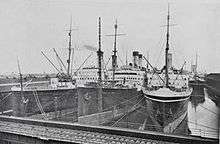CP Ships
 | |
|
| |
Formerly called | Canadian Pacific Steamship Company |
|---|---|
| Industry | Shipping |
| Founded | 1887 in Vancouver, British Columbia, Canada |
| Founder | William Cornelius Van Horne |
| Headquarters | City Place Gatwick, London, UK |
Area served | Global |
Key people | Ronald Niel Stuart, Samuel Robinson, John Wallace Thomas |
CP Ships was a large Canadian shipping company established in the 19th century. From the late 1880s until after World War II, the company was Canada's largest operator of Atlantic and Pacific steamships. Many immigrants travelled on CP ships from Europe to Canada. The sinking of the steamship RMS Empress of Ireland was the largest maritime disaster in Canadian history. The company provided Canadian Merchant Navy vessels in World Wars I and II. Twelve vessels were lost due to enemy action in World War II including the largest ship sunk by a German U-Boat.
The company moved to a model of container shipping from passenger, freight and mail service in the 1960s due to competitive pressure from the airline industry. The company was a part of the Canadian Pacific Ltd. conglomerate. It was spun out as a separate company in 2001. In 2005, it was purchased by TUI AG and is now part of the company's Hapag-Lloyd division.
The Atlantic and Pacific passenger liners of Canadian Pacific were always British-flagged and largely British-manned and were not part of the Canadian Merchant Marine, ownership being with the British-registered Canadian Pacific Steamships Ltd. subsidiary.
History
Early era (1881-1915)
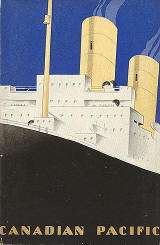
In the early 1880s, the Canadian Pacific Railway (CPR) negotiated with the Government of the United Kingdom to establish a trans-Pacific steamship routes between Vancouver and the Far East.[1] The trans-Pacific services of Canadian Pacific were begun by Sir William Cornelius Van Horne, the Canadian-American builder of the railroad network in 1887. In that year, Sir William chartered three vessels from Cunard Line; the SS Abyssinia, the SS Parthia, and the SS Batavia—as a beginning of the CP fleet.[2] The agency for chartering and managing the ships was secured by Adamson, Bell and Company for the first three years.[3] When the new shipping line had shown to be profitable, Canadian Pacific decided not to renew the contract with Adamson, Bell and Company and to run the line itself.[4]
In 1891, CPR adopted a new name — the Canadian Pacific Steamship Company (CPSC).[5] The CPSC became one of the many shipping companies operating in and out of Liverpool. The company expanded as people emigrating from Europe to North America provided a larger number of passengers and the company also started holiday cruises. As with other shipping companies, CPSC had larger ships built to cope with the demand.[6]
In the late 19th century, CPR initiated an ocean-going service between the port of Vancouver, British Columbia and Hong Kong, with calls at Japan and China, and later at Manila, Philippine Islands and Honolulu, Hawaii. This service provided a link for CPR's transcontinental railroad passenger and freight services. Passengers could travel from England to Eastern Canada, travel across the railway to Vancouver, and on to Asian destinations. During 1887, temporary steamship service was initiated on a Vancouver-Yokohama-Hong Kong route.[7] From 1887 through 1941, the Canadian Pacific Railway provided steamship service between Vancouver and Victoria, British Columbia, Canada and Hong Kong with calls at Japan and China, and later at Manila, Philippine Islands and Honolulu, Hawaii. Three ships were built at Barrow-in-Furness in England, and the three sailed together towards Vancouver in 1890, with initial voyages projected for January 15, February 15, and March 15 of the new year. An 11-foot scale model of the ship was put on display in Canadian Pacific's New York offices. In an effort to lure American Chinese passengers to sail with CPR from North America to Shanghai and Hong Kong, prominent members of the Chinese community in New York were invited to examine the scale model and its amenities.[8]
In 1915, CP changed the name of its shipping business to Canadian Pacific Steamships Ocean Services Ltd.[9]
In 1891, CPR and the British government reached agreement on a contract for subsidized mail service between Britain and Hong Kong via Canada.[10] The route began to be serviced by three specially designed Empress liners—the RMS Empress of China, the RMS Empress of India and the RMS Empress of Japan. Each of these "Empress" steamships sailed regularly in the period from 1891 through 1912. In that year, the Empress of China struck a reef near Tokyo, and she was subsequently towed to Yokohama where she was scrapped. Empress of India would continue in service through 1914. The RMS Empress of Japan sailed regularly from 1891 through 1922. These three ships and the others which comprised the "Empress fleet" carried mail, passengers, and freight speedily across the Pacific for over half a century.[11]
In 1903, the company took over the ships and services of the Beaver Line and began operating ships on the Atlantic between Halifax, Nova Scotia and the United Kingdom. In 1906, two vessels were built in Scotland: the RMS Empress of Scotland and SS Empress of Ireland. These two vessels had a full capacity of 1,530 passengers. There were accommodations for 310 first class, 470 second class passengers, 500 third class and 250 steerage passengers. The CP transported many immigrants from Europe to Canada, primarily from Great Britain and Scandinavia.
CP acquired the successful Allan Line, and expanded to become a major international cargo carrier and operators of luxury passenger liners such as Empress of Britain and Empress of Canada.
Sinking of the Empress of Ireland

In 1914, Empress of Ireland sank after a collision with the Norwegian collier SS Storstad in the St. Lawrence River. In just 14 minutes after the collision, this accident claimed 1,012 lives making it the deadliest maritime disaster in Canadian history.[12][13] Empress of Ireland was heading down the channel near Pointe-au-Père, Quebec in heavy fog. At 02:00 Storstad crashed in the side. Storstad, though damaged did not sink. Empress of Ireland took severe damage to her starboard side and began to list and take on water. Some passengers managed to get into lifeboats quickly. The ship began to list too far, and additional life rafts were not able to be launched. The ship rolled to its side 10 minutes after the collision. Four minutes later the ship had sunk. Only 465 survivors were rescued. A board of inquiry found Storstad responsible for the sinking.
World War I (1914-1918)
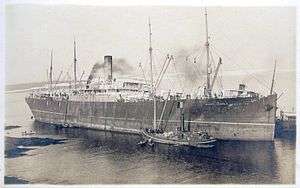
Canadian Pacific was an important contributor to the Merchant Navy (United Kingdom) in World War I. Like other shipping companies, Canadian Pacific provided ships to carry troops in both World Wars. CP lost 18 ships in the war.
In World War I, some ships were refitted as Armed merchantmen or auxiliary minelayers. These were operated by the British Royal Navy, not CP Ships. For example, the RMS Princess Irene and the RMS Princess Margaret were requisitioned at the point of completion by the Royal Navy for war service. They were manned by Navy, not CP. Neither ship was delivered to CP - Princess Irene exploded in 1915 and Princess Margaret was purchased by the Admiralty after the war.
Inter-war period (1919-1938)
CP purchased eleven new steamships to replace its losses during the war. New ships included RMS Empress of Australia, RMS Empress of Britain, SS Duchess of Richmond (RMS Empress of Canada), SS Duchess of Bedford (RMS Empress of France) and SS Duchess of York. The company continued to carry passengers, freight and mail across both the Atlantic and Pacific Oceans. The company also built a fleet of "Beaver Ships", Cargo liners, for fast freight service in the 1920s which were some of the most advanced steam freighters of their time Beaverford, Beaverdale, Beaverburn, Beaverhill and Beaverbrae.[14]
Royal visit to Canada
In 1939, the CP Ship RMS Empress of Australia transported King George VI and his royal consort, Queen Elizabeth from London, England to Quebec City for the 1939 royal tour of Canada. This was the first ever visit by the monarch to a dominion. The King chose to visit Canada using a Canadian luxury liner rather than an established English royal yacht. Empress of Australia was considered to be a royal yacht after her use by the King.
World War II (1939-1945)
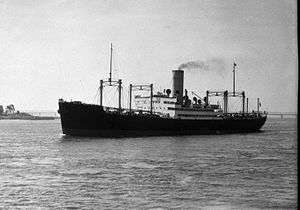
In World War II, the CP fleet carried over a million tons of cargo and a million troops and civilians during the Second World War.[6] One CP ship, the freighter SS Beaverford made the most notable military action in the company's history in 1940 as part of Convoy HX 84 when she engaged the German pocket battleship Admiral Scheer for five hours before sinking with all hands, a sacrifice that allowed most of convoy HX 84 to escape.[15] The Company lost twelve vessels due to enemy action which is a larger loss than any Western company. Empress of Britain was the largest ship lost to enemy action during the Battle of the Atlantic. Losses also included all of its fleet of "Beaver ship" cargo liners. Company ships participated in both the Battle of the Atlantic and the Battle of the Pacific. Despite their extensive and dangerous war service, the CP mariners, part of the Merchant Navy, were denied veterans' benefits by the Canadian Government until 1988.
Post-war period (1945 - 2005)
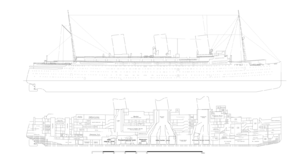
From 1956 to 1961, the company acquired its last three steam passenger ships Empress of Britain, Empress of England and Empress of Canada. Competition from airlines forced CP to retire these ships in the 1970s. The company looked towards bulk and tanker fleets as replacements for its steamships.
In 1971, the company changed its name to CP Ships Ltd. and container ships were added as Intermodal freight transport became popular. Intermodal transportation integrated well with CP's rail assets. In 1972, CP Ships regular transatlantic passenger service from the Port of Liverpool finished with the sale of Empress of Canada.
In 1984, CP Ships entered a joint venture with Compagnie Maritime Belge called Canada Maritime to secure North Atlantic container traffic for its rail facilities at the Port of Montreal. This "new" company prospered and the fortunes of CP Ships revived in the early 1990s. In 1993 Canadian Pacific bought out its partner and merged it with CP Ships. The next decade saw the company grow through acquisition. In April 1995 CP Ships purchased the Cast Group out of a bankruptcy proceeding, and subsequently bought Lykes Lines in July 1997 also out of bankruptcy, Contship Containerlines in October 1997 at a profitable level, Australia-New Zealand Direct Line in December 1998 also being profitable, Ivaran Lines in May 1998 (unprofitable), TMM Lines (unprofitable, 50% in January 1999, rest 50% in January 2000), in August 2000 Christensen Canadian African Lines (CCAL) at small profitability and Italia Line in August 2002 at breakeven business results. By 2001 it was the seventh largest carrier in the world, and dominated the North Atlantic. When it was spun off into a separate company it represented 8% of Canadian Pacific's revenues and was a source for a large portion of CPR's rail traffic — much originating from CP Ships' Montreal Gateway Terminals.
Sale
On August 21, 2005, German conglomerate TUI AG offered to acquire CP Ships Limited for €1.7 billion (US$2.0 billion) in cash, and merge it with TUI's Hapag-Lloyd division.
On October 19, 2005, CP Ships and TUI AG jointly announced that 89.1% of CP Ships shareholders had accepted Ship Acquisition Inc.'s August 30 offer for $21.50 USD per share on October 25, 2005.[16]
In 2011, the company name Canadian Pacific Steamships was abandoned. In 2012, the clothing company, Eyecon Enterprises Inc. (of Ontario, Canada) applied for, and was granted the Canadian Pacific Steamships trademark name along with the "three square" checkered flag graphic logo. In 2013, Canadian Pacific Steamships Limited was incorporated in Ontario, Canada and based out of Newmarket, Ontario.
Fleet events
Civilian
There are several notable civilian events in the CP fleet.
- In 1912 RMS Empress of China struck a reef near Tokyo and was towed to Yokohama and scrapped. All crew and passengers were uninjured.
- In 1914 RMS Empress of Ireland sank in the St. Lawrence River. 1,012 passengers died in the worst maritime disaster in Canadian history.
- In 1918 SS Princess Sophia sank after grounding on Vanderbilt Reef in Lynn Canal near Juneau, Alaska. 343 passengers and crew were lost with the ship. It is the worst maritime disaster in British Columbia and Alaskan history.
- In 1923 RMS Empress of Australia survived the Great Kantō earthquake while in port at Yokohama, Japan. She rescued hundreds of people from the dock, manoeuvred out of port to safety, then provided aid to the population. Capitan Samuel Robinson was awarded the CBE for his actions.
- In 1952 SS Princess Kathleen ran aground and sank in Lynn Canal, Alaska. All crew and passengers were rescued by the United States Coast Guard.[17]
World War I
CP ships served in the Merchant Navy (United Kingdom) in World War I.
- In 1916 SS Mount Temple was taken by SMS Möwe, a merchant raider of the Imperial German Navy. She was scuttled and her British Empire crew was held prisoner of war. American crewmen were released as the United States was neutral at the time. Four crew were killed.
World War II
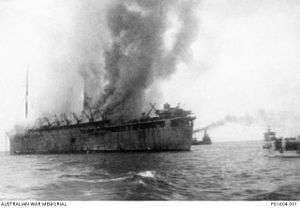
CP ships served in the Canadian Merchant Navy in World War II. Twelve ships were lost to direct enemy action. Two additional ships were lost to accidents.
- In 1940 Empress of Britain was attacked by a Luftwaffe Focke Wulf Condor bomber and, while being towed back to port, was torpedoed by U-32, a Kriegsmarine U-Boat. She was the largest vessel sunk by a U-Boat in WWII. 45 men were lost in the initial attack.
- In 1940 SS Beaverburn was torpedoed by U-Boat U-41. One sailor was lost and 76 were rescued by the US tanker Narraganset.
- In the first hours of 19 June 1940 RMS Niagara sailing from Auckland, New Zealand, sank giving a position of 35° 53′ south, 174° 54′ east in the Hauraki Gulf as a result of an explosion whose origin was not known at the time of distress messages. By afternoon mines identified as German had been swept up.[18] It was later determined that the mines had been laid by the German auxiliary cruiser Orion.[18] All crew members were rescued.
- On 5 November 1941 the SS Beaverford was part of Convoy HX-84. The convoy was escorted only by the Armed Merchant Cruiser HMS Jervis Bay. The convoy was attacked by the German heavy cruiser Admiral Scheer. Jervis Bay attacked Admiral Scheer to give the convoy the chance to scatter and escape but was quickly sunk. When Admiral Scheer caught up with the convoy, the lightly armed (one 4-inch gun) Beaverford turned to attack the cruiser, engaging it four five hours until Beaverford exploded and sank with all 76 crew.[19] Delayed by Beaverford, thirty-two of the convoy ships were able to escape in the darkness with Admiral Scheer destroying only six ships of the convoy.
- In 1941 the SS Beaverbrae was bombed by a Focke-Wulf and sunk. All crew members were rescued.
- In 1941 the SS Beaverdale was torpedoed by U-boat U-48. 21 crew were killed. Captain Draper navigated one lifeboat to 300 miles to Iceland. The other lifeboat was rescued at sea.
- In 1942 RMS Empress of Asia was sunk by 9 dive-bombers of the Imperial Japanese Navy Air Service near Singapore. 40 crewman survived with Leonard H. Johnson awarded the OBE for his actions.
- In 1942 SS Duchess of Bedford sank a U-boat with its deck gun two days out of Liverpool. It also damaged a second one. Captain Busk-Wood was awarded the OBE for this action.
- In 1942 SS Princess Marguerite was sunk by U-83 with over 1,000 troops on board. Swift action from its escorts allowed the rescue of most persons on board. 55 crew were lost with the ship.
- In 1942 SS Duchess of Atholl was sunk by German submarine U-178 2,000 miles off Ascension Island with 831 people on board. 5 crewmen were lost in the initial torpedoing, everyone else was rescued from lifeboats by HMS Corinthian.
- In 1943 RMS Empress of Canada was sunk by an Italian submarine off Cape Palmas. 392 of the 1,800 people on board were killed, many were Italian prisoners of war.
- In 1943 SS Duchess of York was sunk by long range Luftwaffe bombers. Twenty-seven crew were killed.
Notable captains

- Ronald Niel Stuart VC DSO RD RNR (1886–1954) was highly decorated for his service in the Royal Navy during the first World War.[20] In addition to his British decorations, he was honoured with the French Croix de Guerre and the United States' Navy Cross while serving in the Royal Navy during the First Battle of the Atlantic. The remainder of his naval career was spent with Canadian Pacific. A special warrant was written in 1927 which allowed him to fly the Blue Ensign from any ship, mercantile or military, which he commanded.[21] In 1934, he was named Commodore of the CPS fleet and was placed in command of the 42,000 ton liner RMS Empress of Britain on her transatlantic route. In 1937, he was promoted to company superintendent, a role followed by the job of general manager at Canadian Pacific's London office. He retained this job for 13 years, including through the difficult experiences of World War II when London's dockyards were badly damaged by the London Blitz. During this period, he was made a part-time naval aide-de-camp to King George VI in 1941 – a position he held part-time throughout World War II.[22]
- Captain Sir Samuel Robinson KBE (1870–1958) served 37 years at sea on Canadian Pacific vessels. He earned international acclaim as captain of the RMS Empress of Australia which was at Yokohama in Tokyo Bay during the devastating Great Kanto earthquake of 1923. He would be credited with saving the ship, his crew and passengers, and more than 3,000 others during the unfolding catastrophe.[23] Robinson's honours included Commander of the Order of the British Empire (CBE);[24] Knight Commander of the Most Excellent Order of the British Empire (KBE);[23]Order of the Chrysanthemum (Japan);[25] Order of St John of Jerusalem, the Silver Medal (UK);[24] Lloyd's Medal for Meritorious Service (UK);[24] Medal of Honour, Red Ribbon (Japan);[24] Order of the White Elephant (Siam);[23] Cross of the Second Class of the Order of Naval Merit (with white badge) (Spain).[26]
- Captain John Wallace Thomas CBE (1888–1965) served with distinction in both first and second World Wars. He was appointed as a Commander of the Order of the British Empire (CBE) for his handling of the RMS Empress of Scotland during an attack by the Luftwaffe off the coast of Ireland on November 9, 1940. Captain Thomas was the only member of the Canadian merchant navy to have been honoured with the CBE during that war.
Corporate timeline
- 1881 Canadian Pacific Railway was founded.
- 1891 Shipping assets are incorporated into Canadian Pacific Steamship Company.
- 1915 Name changed to Canadian Pacific Steamships Ocean Services Ltd.
- 1971 Name changed to CP Ships Ltd.
- 2001 CP Ships Ltd. is spun out from the conglomerate Canadian Pacific Limited and became an independent company.
- 2005 CP Ships Ltd. is acquired by TUI AG.
- 2011 Canadian Pacific Steamships trade name abandoned.
- 2012 Canadian Pacific Steamships trade name and chequered flag graphic are registered as trademarks of Eyecon Enterprises Inc. (Province of Ontario, Canada).
- 2013 Canadian Pacific Steamships Limited is incorporated in the Province of Ontario as a clothing company.
See also
Notes
- ↑ "Canadian Railroad Interests; To Connect with Steamships to Japan," New York Times. November 28, 1884.
- ↑ "Pacific Air Routes Replace Ship Line; Canadian Company Abandons Pre-War Service of Fleet, Maps Overseas Flights," New York Times. April 10, 1949.
- ↑ Carol Matheson Connell, "A Business in Risk - Jardine Matheson and the Hong Kong Trading Industrie", Praeger Publishers, Westport 2004, p.5, ISBN 0-275-98035-9
- ↑ Stephanie Jones, "Two Centuries of Overseas Trade - The Origins and Growth of the Inchcape Group", The Macmillan Press, Basingstoke 1986, p.174, ISBN 0-333-37172-0
- ↑ Tate, E. Mowbray. (1986). Transpacific Steam: The Story of Steam Navigation from the Pacific Coast of North America to the Far East and the Antipodes, 1867–1941, p. 144.
- 1 2 E. Chambré Hardman Archive: CP Innovations.
- ↑ "Railway Management; the Canadian Pacific." New York Times. May 13, 1887.
- ↑ "The Chinamen Were Pleased; They Viewed the Model of the Canadian Pacific's New Ships." New York Times. December 23, 1890.
- ↑ "To Transfer C. P. R. Fleet; Ships and Railroad to be Managed by Separate Companies," New York Times. February 25, 1915; "Canadian Pacific Divorces Ships; Forms Company to Take Over Its Boats and Those of the Allan Line, Which It Owns. PRICE IS PUT AT $24,000,000 Railway to Get All of New Corporation's $10,000,000 Stock and $14,000,000 Debentures," New York Times. August 24, 1915.
- ↑ "Rivals of Pacific Mail; Canadian Pacific Steamers Cutting into China Traffic," New York Times. October 10, 1891.
- ↑ Postal History Society of Canada:trans-Pacific mail service and the "Empress fleet"
- ↑ Investigating the Empress of Ireland. Shipwreck Investigations at Library and Archives Canada.
- ↑ The Golden Age of Liners. BBC Four. Timeshift, Series 9, Episode 2.
- ↑ "SS Beaverford", Clydebuilt Canada’’
- ↑ [Peter Pigott, ‘ ‘ Sailing Seven Seas: A History of the Canadian Pacific Line’ ‘, Dundurn Press, 2010, p. 139.]
- ↑ Press release, October 19, 2005
- ↑ Cruise line history. Retrieved 2013-01-10
- 1 2 Gill, G. Hermon (1957). Royal Australian Navy 1939-1942. Australia in the War of 1939–1945. Series 2 – Navy. 1. Canberra: Australian War Memorial. pp. 125–126.
- ↑ The Story of Beaverford
- ↑ The London Gazette: (Supplement) no. 30194. p. 7424. 20 July 1917. Retrieved 2008-05-28.; The London Gazette: (Supplement) no. 31021. p. 13694. 19 November 1918. Retrieved 2008-05-28.
- ↑ Snelling, Stephen. 2002. The Naval VCs, p. 142.
- ↑ Obituary for Captain Ronald Neil Stuart, The Times Retrieved 23 May 2007
- 1 2 3 "Capt. Samuel Robinson, Who Won Fame For Rescue Work in Jap Quake, Dies," New York Times. September 7, 1958.
- 1 2 3 4 National Maritime Museum, Greenwich
- ↑ Vancouver Maritime Museum
- ↑ The London Gazette: no. 32973. p. 6778. 12 September 1924. Retrieved 2008-04-23.
References
- Musk, George. (1981). Canadian Pacific: The Story of the Famous Shipping Line. Toronto: Holt, Rinehart and Winston of Canada. ISBN 978-0-03-920291-0; OCLC 7540915
- Snelling, Stephen. 2002. The Naval VCs. Stroud, Gloustershire: Sutton. ISBN 978-0-7509-1395-9
Further reading
- History of CP Ships - Hapag Lloyd
- The Role of the CP Ships in World War II
- EDGAR Online: CP Ships Limited - Revised 2003 Annual Information Form, 7 September 2004
External links
| Wikimedia Commons has media related to Canadian Pacific Steamship Company. |
- CP Ships (Archive)
- White Empress fleet list: 20 vessels
- "CP Ships – Canadian Pacific – Posters and Ads"
- New York Public Library Digital Gallery:
- NYPL ID 97712, unknown photographer: Empress of Canada, portside view
- NYPL ID 97717, unknown photographer: Empress of Scotland, starboard view
